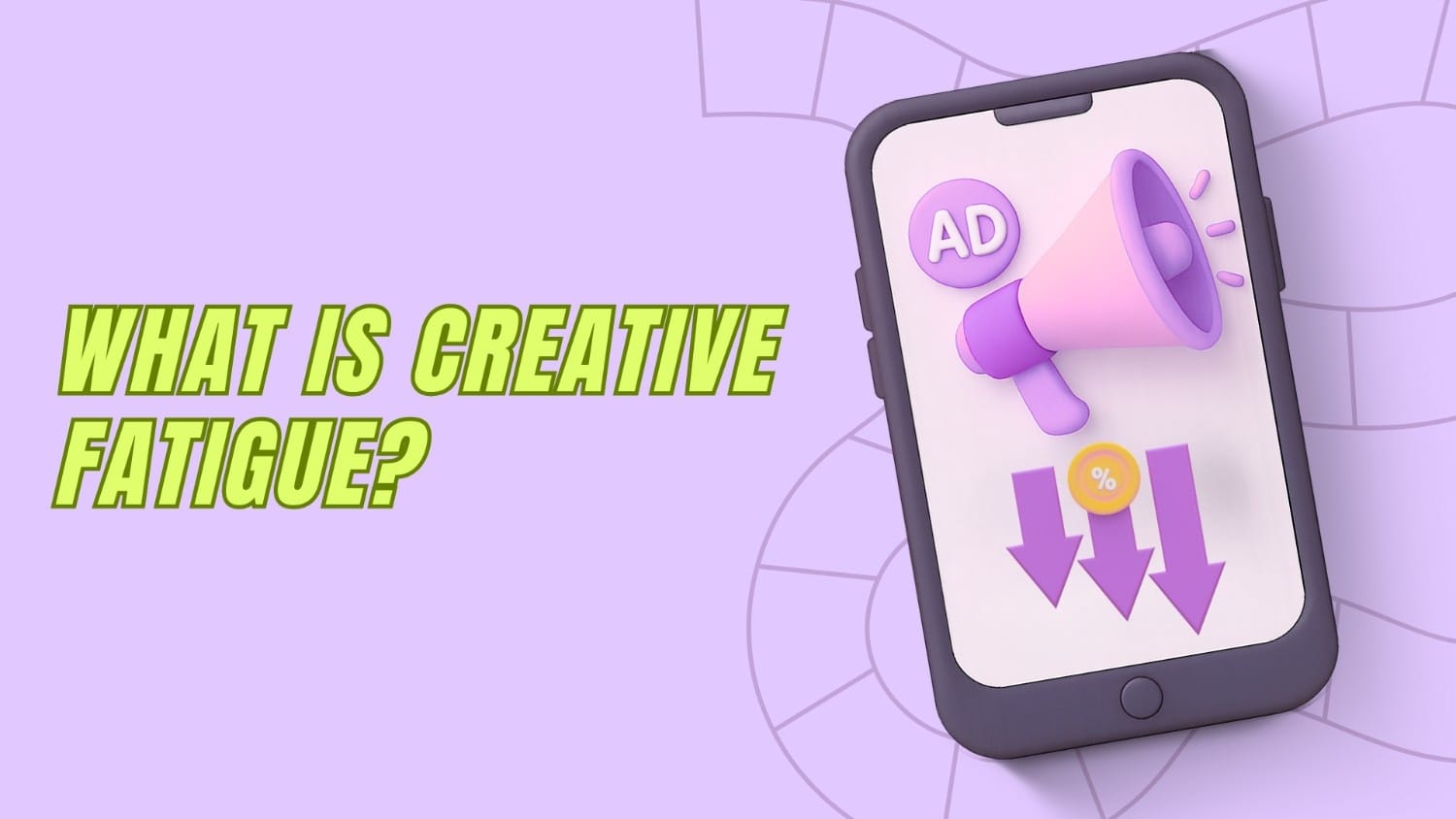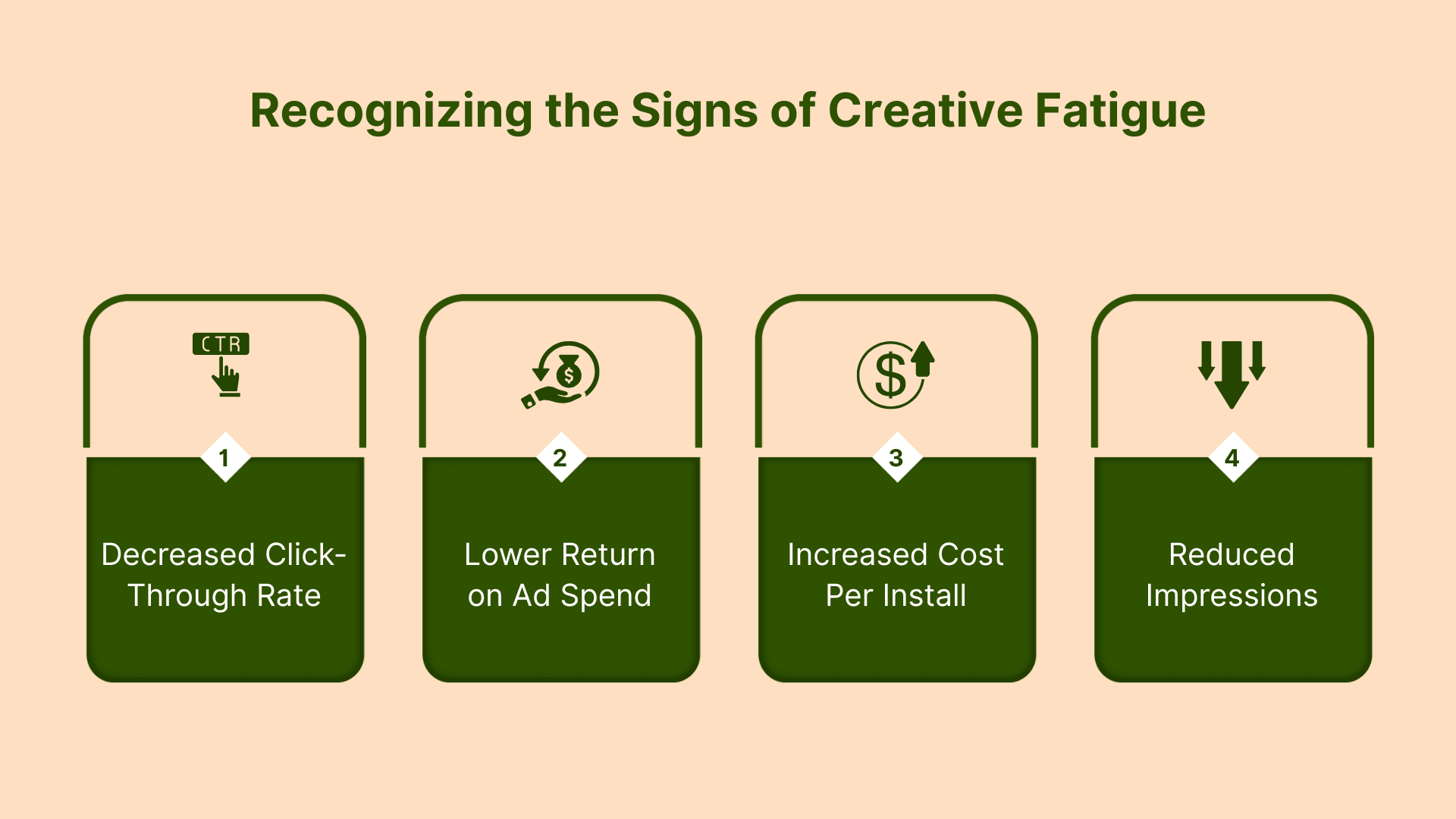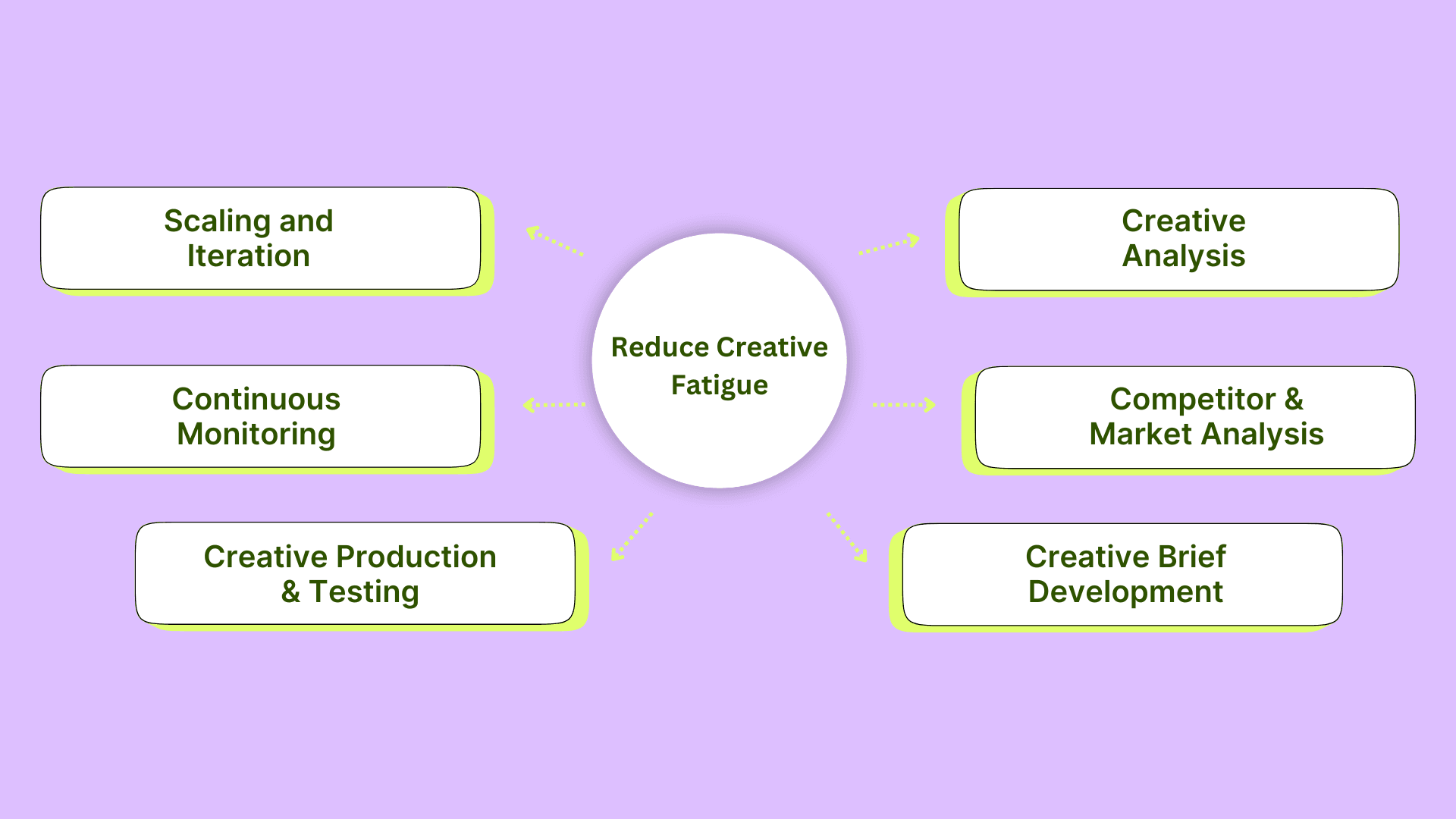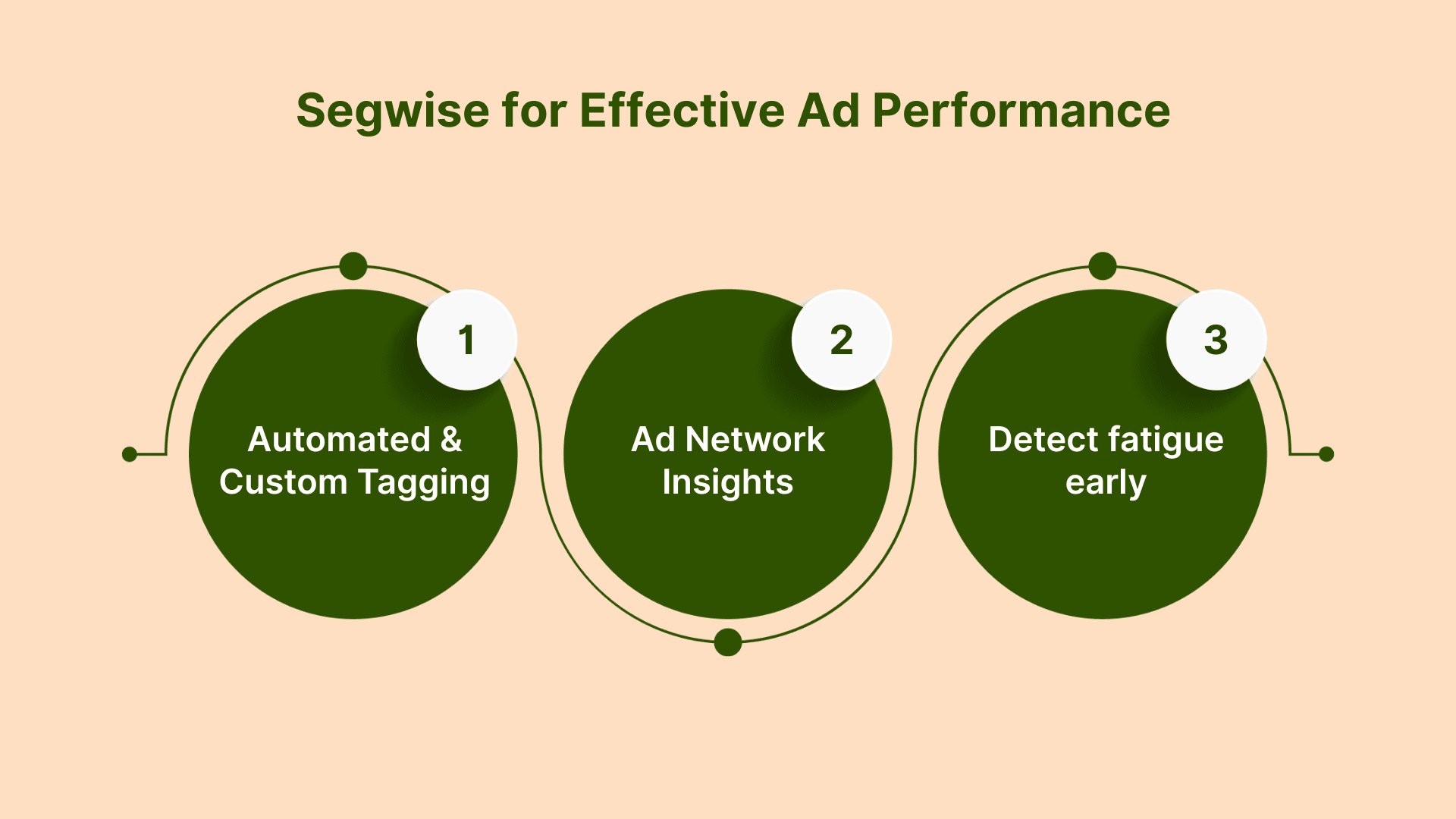Creative Fatigue: Understanding and Managing Ad Performance
Are your ad creatives no longer yielding the results they once did? As a mobile game marketer, you know how crucial it is to attract new players constantly. But what happens when your ads start losing their impact? When your target audience no longer finds your ads compelling, the results can be discouraging.
This is where creative fatigue comes in. It occurs when your audience becomes oversaturated with the same ads, causing them to tune out and stop engaging. This leads to a decline in user acquisition, and without fresh creatives, your campaigns can quickly lose their effectiveness.
Are you also noticing a drop in player engagement despite your best efforts? This blog covers how creative fatigue impacts your campaigns and how you can manage it to maintain fresh, compelling ads. We'll guide you through identifying signs of creative fatigue, understanding its impact on your ad performance, and implementing a framework to maintain strong and effective user acquisition efforts.
What is Creative Fatigue

Creative fatigue occurs when ad creatives lose their effectiveness due to repeated exposure to the same audience. In mobile game marketing, this means that potential players become less responsive to your ads over time, leading to decreased engagement and higher costs per install.
This phenomenon is particularly prevalent in user acquisition campaigns where the same creatives are shown to the same users multiple times. Repetitive use of the same video ads, static images, or playable demos causes audience attention to fade, reducing engagement over time. As a result, your ads may no longer capture attention, and your user acquisition efforts may fail.
Once you understand what creative fatigue is, it's important to know how to identify its early signs before it impacts your campaigns.
Also Read: Generating Successful Ad Creatives with AI
Recognizing the Signs of Creative Fatigue
In mobile game marketing, it's crucial to stay vigilant about the performance of your ad creatives. Over time, even the most engaging ads can lose their effectiveness. Recognizing the signs early can let you take proactive steps to refresh your campaigns and maintain a steady influx of new players.
Here are some of the key metrics to watch out for:

Decreased Click-Through Rate (CTR): CTR measures how effective your ad is at capturing attention. A decline in CTR suggests that your audience is losing interest in your creatives and is less likely to take action, such as installing your game.
Lower Return on Ad Spend (ROAS): When users start ignoring your ads, it impacts engagement and conversion rates, ultimately lowering your ROAS. This signals that your current ads are not driving the same returns, indicating creative fatigue.
Increased Cost Per Install (CPI): If you notice an increase in Cost Per Install (CPI), it’s often a result of creative fatigue. As your audience becomes less responsive to repetitive content, you'll need to spend more to achieve the same results.
Reduced Impressions: If your ads are no longer showing up as frequently in users' feeds, it’s a sign of creative fatigue. Social media algorithms prioritize engaging content, so when your ads fail to spark interest, they are less likely to be featured. A consistent drop in impressions indicates it’s time to refresh your creatives.
Regularly reviewing these metrics is crucial for identifying early signs of creative fatigue. By monitoring these key metrics, you can pinpoint underperforming creatives and take timely action to refresh them, ensuring continued success in acquiring new players.
To address creative fatigue effectively, it’s essential to implement a structured approach. Here’s a framework to help you reduce creative fatigue and maintain high-performing ad creatives.
Framework to Reduce Creative Fatigue
Creative fatigue is a significant challenge in mobile game user acquisition, resulting in decreased engagement and higher costs per install (CPA). Here is a structured approach to reducing creative fatigue and improving ad performance:

1. Creative Analysis
Begin by evaluating the performance of your existing ad creatives. Focus on key metrics such as click-through rate (CTR), cost per install (CPI), and return on ad spend (ROAS). Identify patterns indicating creative fatigue, such as declining CTR or increasing CPI. This analysis provides a baseline to understand which creatives are underperforming and why.
2. Competitor and Market Analysis
Conducting thorough research on competitors creatives across various platforms is essential for understanding gaming trends and audience preferences. By analyzing top-performing ads, you can identify successful strategies and potential gaps in the market. This analysis offers valuable insights into what resonates with your target audience and informs the direction of your own creative efforts.
Segwise enhances this analysis by offering a free Meta Ad Library Tracker. This tool allows you to monitor up to five competitors simultaneously, providing updates on their latest ads within the past seven days. The dashboard lets you compare strategies, spot trends, and identify opportunities. This tool streamlines competitor analysis, saving time and enhancing your user acquisition efforts.
3. Creative Brief Development
Craft a detailed creative brief that aligns with your game's unique selling points and target audience. Involve cross-functional teams, including game designers, to ensure the brief captures the essence of the game and resonates with potential players. This collaborative approach ensures that the creatives are not only visually appealing but also strategically sound.
4. Creative Production and Testing
Develop a diverse set of ad creatives based on the insights from your creative brief and market analysis. Implement A/B testing to evaluate the performance of different creative variations. For example, test different call-to-action placements or visual styles to identify which elements resonate most with your target audience.
5. Continuous Monitoring and Optimization
Regularly monitor the performance of your active ad creatives using key performance indicators such as click-through rate (CTR), cost per install (CPI), and return on ad spend (ROAS). Identify signs of creative fatigue, such as declining CTR or increased CPI, and take prompt action to refresh underperforming creatives. Allocate 10–15% of your budget to test new creative concepts, ensuring a continuous influx of fresh content to maintain audience engagement.
6. Scaling and Iteration
Once effective creatives are identified, scale their usage across various channels and demographics. Continue to test new ideas and refine existing ones to adapt to changing audience preferences and market dynamics. This iterative process ensures sustained user acquisition and mitigates the risk of creative fatigue.
By adopting this structured creative framework, you can systematically reduce creative fatigue and enhance ad performance, leading to more efficient user acquisition and improved return on ad spend.
To implement the strategies for reducing creative fatigue, leveraging the right tools can significantly enhance your ad performance.
Also Read: Creative Testing Strategies for Mobile UA Campaigns in 2025
Utilizing Segwise for Effective Ad Performance
Creative fatigue can silently erode your campaign performance, leading to increased costs and diminished returns. Recognizing and addressing this issue promptly is crucial for maintaining a healthy return on ad spend (ROAS).
Segwise's Creative Analytics AI Agent is designed to help you identify and manage creative fatigue effectively. By automating the analysis of your ad creatives, Segwise provides insights into which elements are driving performance and which may be underperforming. This allows you to make data-driven decisions to refresh your creatives and optimize your campaigns.

Key Features:
Automated and Custom Tagging of Creative Elements: Segwise's AI automatically tags various components of your ad creatives, such as visuals, text, and calls-to-action. You can also create custom tags to track specific elements unique to your campaigns.
Aggregated Insights Across Ad Networks: Consolidate performance data from every ad platform and mobile measurement partner into one dashboard, enabling you to pinpoint top‑performing assets and optimal tag combinations by geography and network. This helps in identifying trends and patterns that influence user acquisition.
Performance detection for early signs of fatigue: Monitors the performance of your creatives and continuously tracks engagement metrics, sending alerts when creative fatigue is detected. This allows you to identify declining CTR, IPM, or ROAS early, enabling you to test fresh variations and maintain peak UA efficiency.
Conclusion
Creative fatigue can hinder your mobile game user acquisition, leading to lower engagement and higher costs per install. Recognizing early signs and adopting a structured framework helps keep your campaigns fresh and compelling. Key strategies, such as competitor analysis, A/B testing, and continuous optimization, are crucial to maintaining strong ad performance.
So, why wait? Try our 14-day free trial today to effectively combat creative fatigue, keep your ad creatives fresh, and improve user acquisition.
FAQs
1. What role does audience targeting play in creative fatigue?
Targeting the same audience repeatedly with the same creatives can accelerate creative fatigue. It's important to periodically refresh your audience segments and tailor creatives to different user groups to maintain engagement and reduce fatigue .
2. How can I utilize user feedback to refresh my ad creatives?
Analyzing user interactions, comments, and feedback on your ads can provide valuable insights into what resonates with your audience. Incorporate this feedback into your creative development process to make informed adjustments that align with user preferences.
3. How can I collaborate with my creative team to combat fatigue?
Establish clear communication channels between your user acquisition and creative teams to ensure seamless collaboration and effective teamwork. Regular brainstorming sessions, sharing performance data, and aligning on campaign goals can lead to the development of fresh and compelling ad creatives that resonate with your target audience.
4. How can I maintain creative diversity in my campaigns?
Regularly introducing new themes, formats, and messaging into your ad creatives ensures diversity and innovation. This approach keeps your content engaging and prevents users from becoming accustomed to repetitive ads, thereby mitigating creative fatigue.
5. How can I differentiate between creative fatigue and ad fatigue?
Creative fatigue occurs when the audience becomes disengaged due to repetitive ad content, even if the specific ad isn't shown too frequently. Ad fatigue, on the other hand, occurs when the same ad is repeatedly shown to the same users, resulting in decreased engagement. Both require distinct strategies to be addressed effectively.

Comments
Your comment has been submitted successfully!